|
 Secure Site
Secure Site
|
 |
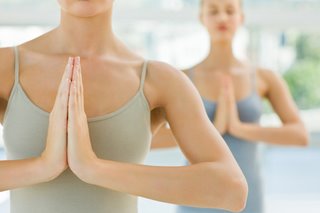 breathing to calm down What You’ll Need
A timer or stopwatch; a folded blanket or firm cushion.
What It Does
This practice calms the mind and the central nervous system, helping put the brakes on a frenzied pace. “When you slow your breathing down, you slow your life down,” says Strom. Plus, it can spark your creativity. “I’ve had students stop in the middle of class and grab a pen. When the mind chatter stops, the ideas fly in.”
How to Do It
Set your Zen Timer with bowl for three minutes so you don’t have to keep track. Be sure to keep your spine erect. (Slouching can inhibit deep breathing.)
-Begin to lengthen the inhalation and exhalation (breathing slowly through your nose). First try inhaling for a count of four and exhaling for a count of four, then lengthen (aim for a count of seven on the in breath and seven on the out breath).
-Be careful not to hold your breath. You want to slow it down, not stop it.
-When the timer goes off, return to a normal breathing pace.
Use our unique “Zen Clock” which functions as a Yoga Timer. It features a long-resonating acoustic chime that brings your meditation or yoga session to a gradual close, preserving the environment of stillness while also acting as an effective time signal. Our Yoga Timer & Clock can be programmed to chime at the end of the meditation or yoga session or periodically throughout the session as a kind of sonic yantra. The beauty and functionality of the Zen Clock/Timer makes it a meditation tool that can actually help you “make time” for meditation in your life. Bring yourself back to balance.
adapted from Body + Soul, December 2006
 Zen Timer with Bowl Now & Zen – The Yoga Timer Store
1638 Pearl Street
Boulder, CO 80302
(800) 779-6383
Posted in Meditation Tools, mindfulness practice
 yoga and menopausal hormones Menopausal hormone shifts can rearrange your body and mind in unnerving ways. Let yoga bring you back into balance.
Clients at Kay Lee’s hair salon in Studio City, California, have gotten used to seeing its owner standing on her hands in a corner of the room. Lee, who’s 51, has been practicing yoga since she was in her early 20s. But she began a more dedicated practice about six years ago, when she realized she needed help managing the symptoms of perimenopause. “I was around lots of older women at the salon, and we would all talk about the changes we were going through,” she says. “Watching them go through their menopause, I realized I needed to find a good way to cope with it.”
Like many other women, Lee suspected that menopause might bring unpleasant symptoms. But when, in her 40s, she began experiencing perimenopause—a constellation of premenopausal changes that often includes hot flashes, insomnia, anxiety, irregular periods, heavy bleeding, forgetfulness, and fatigue—she discovered that she was unprepared.
For Lee, the symptoms that hit hardest were irritability and mood swings. She’d grown accustomed to juggling midlife responsibilities: running her business and household, tending to her marriage, raising two children. But her emotions sometimes flared out of control as she moved into perimenopause. The worst episodes occurred during her two-hour freeway commute from her home in Ojai, California, to the salon, and back again—a drive that grew more frustrating the deeper into perimenopause she got. “Road rage,” she says ruefully. “I would have a lot of road rage.”
Between the aggression, sleepless nights, and hot flashes, Lee decided she needed help. She knew women from the salon who were using hormone therapy, typically a combination of the female hormones estrogen and progesterone, but Lee wanted a more natural approach. She had taken classes sporadically in the past with Ojai yoga teacher Suza Francina, author of Yoga and the Wisdom of Menopause. Now that Lee needed help with the menopausal transition, she started going to Francina’s classes two to three times a week. She also began taking breaks during her busy workday to spend at least a few minutes doing yoga.
Fog-free zone
After several weeks of regular practice, Lee felt much better: Her moods stabilized, and her thinking became sharper. Even her PMS symptoms improved. Longtime yogis, of course, know that the practice can bring benefits like calmness, mental clarity, strength, and focus to people of any age. But for women experiencing the physical, mental, and emotional throes of the menopausal years, yoga’s gifts are particularly welcome.
“Menopause is like going through puberty, only in reverse,” Francina says. “By replenishing energy and soothing the nervous system, yoga goes to the root of a wide range of symptoms,” she says. Yoga teachers like Francina aren’t the only people who think that yoga can help. Because hormone therapy can raise the risk of heart disease, stroke, blood clots, and breast cancer, medical researchers have been searching for gentler ways to ease women through the menopausal transition. Although the research is still in its early stages, several studies have pointed to important ways that yoga can make a difference.
In 2005 Beth Cohen, an internist at both the University of California, San Francisco, and San Francisco VA Medical Center, studied the effects of yoga on hot flashes in a small pilot study of 14 women. The women in the study took part in a weekly 90-minute yoga class designed around eight restorative poses. They also practiced for one hour at home three days a week. After eight weeks, the frequency of the women’s hot flashes decreased by 30 percent and their severity diminished by 34 percent. Cohen suspects that the results may be due to yoga’s ability to calm the sympathetic nervous system, although she can’t yet be certain, because researchers don’t fully understand what causes hot flashes.
Cohen says that the study also revealed some unexpected findings, such as improved sleep among the participants. But since the study didn’t include a control group, it’s hard to say whether some of the response can’t be chalked up to the placebo effect. Last year, however, researchers in Bangalore, India, examined how yoga affected menopausal symptoms in a larger group of 120 women, this time with a comparison group. Half the women took yoga classes five days a week for an hour a day, while the others did supervised gentle exercise. After eight weeks, the yoga group had substantially fewer menopausal symptoms—hot flashes, memory problems, and sleep disturbances—as well as lower scores on a measure of perceived stress. There’s also evidence that yoga can do more than just ease bothersome symptoms. Kim Innes, assistant professor at the University of Virginia’s Center for the Study of Complementary and Alternative Therapies, reviewed the medical literature about ways that yoga (and other mind-body practices, including tai chi) may affect the physiological and neuropsychological processes that contribute to the increase in heart disease risk for postmenopausal women.
The hormonal changes that occur during menopause, particularly the sharp drop in estrogen, can lead to numerous health changes that make women much more vulnerable to heart disease and other chronic conditions. For instance, menopause itself is associated with a rise in insulin resistance and other adverse changes, including high blood pressure. Insulin resistance is a precursor to diabetes, in which the body becomes less sensitive to insulin, in turn causing blood-sugar levels to rise. In addition the menopausal transition is associated with increased activation of the sympathetic nervous system and related deterioration in both mood and sleep. All of these factors are interrelated, and all raise the risk for heart disease.
Yoga, Innes says, has been shown to counter these risk factors. “I wasn’t expecting to see such a widespread effect on so many parameters,” she says. “But the more you look, the more you see that so many of these are related to stress. And the thing that’s startling is how quickly these beneficial changes can occur, even over the course of six weeks or less.”
Restoratives to the Rescue
No single sequence will provide surefire relief for every woman, says Elise Browning Miller, an Iyengar Yoga teacher in Palo Alto, California, who teaches workshops on yoga for menopause. Browning Miller and other teachers agree on a few general principles for practicing during menopause.
Women who are experiencing a lot of emotional turmoil may find standing poses like Prasarita Padottanasana (Wide-Legged Standing Forward Bend) to be grounding and stabilizing, says Browning Miller. If heavy bleeding is a problem, inversions such as Salamba Sarvangasana (Supported Shoulderstand) can help reduce bleeding, she says.
For postmenopausal women who want to maintain strong bones and prevent the wrist fractures common among this group, Miller recommends practicing asanas that put weight on the hands and forearms. These include poses such as a supported version of Adho Mukha Svanasana (Downward-Facing Dog Pose), using a strap around the elbows or putting the forearms on the floor. Resting the head on the floor or on a block during the pose can also help ease emotional upset.
But for many women during this time, restorative poses are the most crucial asanas of all. “When your body is going through changes, you need more rest,” Francina says. “No aspect of yoga is more important during this time than to take time every day to practice at least one restorative pose. This is a time for a peaceful, deep approach, with plenty of props so you can enjoy staying in poses longer.”
Life Support
As for how often to practice, the consensus is at least twice a week: “Enough that you let it spill into your life,” Miller says. “There’s something about twice a week that has a multiplicative effect.”
Lee says that she can’t imagine her life these days without yoga. She practices at the beginning or end of her day for at least 20 minutes, focusing on restorative poses. And she continues to attend classes at Francina’s studio two or three days a week. The benefits go beyond the physical. Because her mother died at 52, Lee hasn’t had an up-close role model to show her how to move gracefully into the next stage of her life. The women in her yoga classes, some of whom are in their 80s, have helped to fill that void. “Yoga gave me a support group of women who are my elders,” Lee says. “When we practice together, I feel really supported.”
At Lee’s salon, she says, the topics of perimenopause and menopause come up all the time. When women come in for a haircut but wind up telling Lee that they’re fatigued or having mood swings, she passes on yoga tips that might help them feel better. In addition to having her mat at the salon, she also keeps a block, a strap, and a bolster on hand. “I’ve shown so many clients Viparita Karani,” she says. “They initially come for a beauty treatment. I try to remind them that beauty comes from inner balance and health.”
At Rest in Transition
Make restorative poses the core of your practice during the menopausal transition, says yoga teacher and author Suza Francina. “I call these the essential poses for crossing the menopausal bridge. They will carry you to the next phase of your life.” Francina recommends staying in the first two poses for 10 minutes or longer, and the third for 5 minutes or longer.
Supta Baddha Konasana (Reclining Bound Angle Pose), supported
Sit on your mat in front of a bolster placed lengthwise behind you. Loop a strap behind your back at your sacrum. Bring it forward around your hips and over your shins, and secure it under your feet so that it encircles the lower part of your body. Place the soles of your feet together and put a folded blanket or block beneath each of your outer thighs. Lie back with your spine centered on the bolster and with your arms out to the sides, palms up. |
 |
Setu Bandha Sarvangasana (Bridge Pose), supported
Place a bolster or two folded blankets on your mat, and lie back over them so that they support your back rib cage but allow your upper back and shoulders to reach toward the floor. Place the soles of your feet together, cross your shins, or bend the knees and keep feet flat on the floor. More-experienced yogis can practice with the legs straight and the feet on a block. Let your arms rest out to the sides or stretch them overhead with elbows bent and palms facing up. |
 |
Viparita Karani (Legs-up-the-Wall Pose), supported
Place a bolster or two folded blankets about six inches away from the wall (the exact distance depends on your leg flexibility and comfort). Sit sideways on the bolster, with the side of your hip touching the wall. With the bolster under your bottom, lower yourself back and swivel around so that your torso is perpendicular to the wall and your legs are extended up it. Let your arms rest out to the sides, palms up. In the beginning, stay about 5 minutes, and gradually increase the time to 10 minutes or longer. |
 |
adapted from Yoga Journal by Katherine Griffin, a former editor at Yoga Journal, is a San Francisco Bay Area writer.
Our Zen Timepiece’s acoustic 6-inch brass bowl-gong clock is the world’s ultimate alarm clock, practice timer, and “mindfulness bell.” The Singing Bowl Gently reminds you to change position when practicing yoga each day.
This unique “Zen Clock” features a long-resonating acoustic chime that brings the meditation or yoga session to a gradual close, preserving the environment of stillness while also acting as an effective time signal.
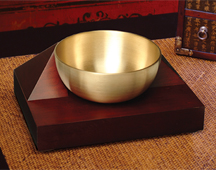 Yoga Timer with Singing Bowl - Now & Zen, Inc.
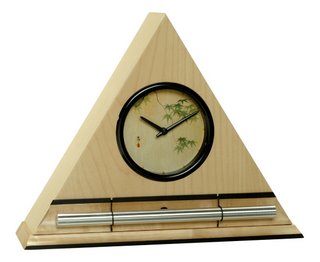 Zen Chime Alarm Clock and Yoga Timer Now & Zen’s Yoga Timer Shop
1638 Pearl Street
Boulder, CO 80302
(800) 779-6383
Posted in yoga, Yoga Timer, Yoga Timers by Now & Zen
 how to begin a meditation practice One effective stress-relief strategy is meditation: It’s free, it can be done almost anywhere at any time, and you don’t need any special equipment to practice. “Meditation teaches us focused concentration — and the more you do it, the easier it gets,” says Frank Lipman, M.D., holistic physician and creator of our Stress Relief Action Plan. The exercise below is adapted from Lipman’s book “Revive: Stop Feeling Spent and Start Living Again” (Fireside; 2009).
If taking up meditation seems daunting, however, start with devoting just 15 minutes a day to this beginner-friendly technique. Once you’ve made it a habit, deepen your practice with the additional technique below.
1. Set your Singing Bowl Gong Timer (Now & Zen, $199.95) for 15 minutes. Sit in a chair and allow your body to settle.
2. Slowly scan your body from toe to head, noticing where you feel tight.
3. Bring your attention to your breathing, inhaling and exhaling through the nose but never forcing your breath. Keep your mouth softly closed, your jaw relaxed.
4. Become more and more sensitive to your breath, in tune with where your body moves (and doesn’t move) on the inhale and exhale.
5. Allow your awareness of your breath to bring ease to your entire body. Imagine your body moving toward the earth, fully supported.
6. Continue observing your breath moving in and out of your body.
7. At the end of the 15 minutes when you hear the gentle chime from your Zen Timer, breathe deeply three times, allowing the inhale to move down to your toes and the exhale to move up and out of the tops of your shoulders. Pause and then open your eyes.
adapted from Body + Soul, January/February 2010
Our Zen Timepiece’s acoustic 6-inch brass bowl-gong clock is the world’s ultimate alarm clock, practice timer, and “mindfulness bell.” It has a beautiful Singing Bowl Gong that chimes.
 Singing Bowl Gong Meditation Timer and Alarm Clock
Now & Zen’s Singing Bowl Gong Timer Store
1638 Pearl Street
Boulder, CO 80302
(800) 779-6383
Posted in intention, Meditation Timers, Meditation Tools, mindfulness practice
 Procrastinator Sleep Type: The Procrastinator
You get tired early in the evening, but by the time you go to bed, you’re wide awake.
What’s Going On?
Our bodies have two different mechanisms, one for sleep and one for wakefulness. Paul Glovinsky, Ph.D., coauthor of “The Insomnia Answer,” calls them the sleep drive and the alerting force, respectively. The problem is, these two forces can often be at odds with each other.
“The sleep drive depends on the fact that we’ve been up for a certain amount of hours, building the need for sleep,” he says. The longer we’re awake, the more intense it gets. But napping early in the evening or zoning out while watching TV can partially satisfy that sleep drive — so come bedtime, the alerting force has the upper hand, making it hard to nod off. For many people, adds Rubin Naiman, Ph.D., director of Sleep Programs at Miraval Resort, there’s “an ideal window of opportunity for falling asleep.”
What to Do
For starters, be aware of your sleep drive. If you feel yourself starting to doze off in the early evening — at dinner, for instance, or while reading or watching TV — get up and walk around. “It doesn’t take a lot. You don’t have to get up and run a mile,” explains Charles Atwood, Jr., M.D., associate director of the Sleep Medicine Center at the University of Pittsburgh Medical Center. “Just walk around your house a little bit. Usually that’s enough to keep you alert for another hour or so.”
However, if you feel yourself getting tired later in the night (say after 9 p.m. or so), don’t force your body to burn the midnight oil unless you really have to. As Bala Manyam, M.D., a neurologist and Ayurvedic expert, puts it, “Mother Nature is telling you, ‘You silly human being. You’re tired. Go to sleep now.'”
Waking up in the morning should be as pleasant as falling asleep at night. The Zen Alarm Clock’s gradual, gentle awakening is transformative.
“The Zen Alarm Clock,” uses soothing acoustic chimes that awaken users gently and gradually, making waking up a real pleasure. Rather than an artificial recorded sound played through a speaker, the Zen Clock features an alloy chime bar similar to a wind chime. When the clock’s alarm is triggered, its chime produces a long-resonating, beautiful acoustic tone reminiscent of a temple gong. Then, as the ring tone gradually fades away, the clock remains silent until it automatically strikes again three minutes later. The frequency of the chime strikes gradually increase over ten-minutes, eventually striking every five seconds, so they are guaranteed to wake up even the heaviest sleeper.
Adapted from Body + Soul Magazine, May 2008 by Sarah Schmelling
Boulder, Colorado—an innovative company has taken one of life’s most unpleasant experiences (being startled awake by your alarm clock early Monday morning), and transformed it into something to actually look forward to. “The Zen Alarm Clock,” uses soothing acoustic chimes that awaken users gently and gradually, making waking up a real pleasure. Rather than an artificial recorded sound played through a speaker, the Zen Clock features an alloy chime bar similar to a wind chime. When the clock’s alarm is triggered, its chime produces a long-resonating, beautiful acoustic tone reminiscent of a temple gong. Then, as the ring tone gradually fades away, the clock remains silent until it automatically strikes again three minutes later. The frequency of the chime strikes gradually increase over ten-minutes, eventually striking every five seconds, so they are guaranteed to wake up even the heaviest sleeper. This gentle, ten-minute “progressive awakening” leaves users feeling less groggy, and even helps with dream recall.
 Natural Awaking Clock with Chime Sounds Now & Zen’s Alarm Clock and Meditation Timer Store
1638 Pearl Street
Boulder, CO 80302
(800) 779-6383
Posted in Bamboo Chime Clocks, Chime Alarm Clocks, Natural Awakening, Now & Zen Alarm Clocks, sleep, Sleep Habits
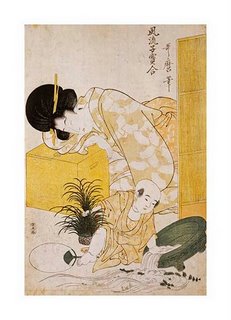 UTAMARO, Kitagawa, A Mother Dozing While Her Child Topples a Fish Bowl Sleep doesn’t worsen with age, study shows
By Shari Roan, Los Angeles Times
The myth that you sleep worse as you get older isn’t true, scientists argued in a study published Thursday. While older people may have more sleep disturbances than younger people, those problems are linked to illnesses and health issues and have little to do with aging, researchers said.
The study, published in the journal Sleep, examined sleep quality in a more than 150,000 Americans. The survey participants were asked about sleep quality, sleep disturbances and daytime fatigue as well as many questions on race, income, education, mood and their general health.
The research showed that sleep quality tended to improve over one’s lifetime – except for an uptick in sleep problems reported in middle age, especially among women. People age 80 and older scored the highest on sleep quality relative to other age groups.
It’s not clear why older people reported fewer sleep disturbances and tiredness, the authors said. It could be that older people have more control over sleep duration while younger people experience more stressors (jobs, kids, socializing) that interfere with sleep. It’s also possible that older people are just more accepting of sleep quality and don’t complain about it as much.
 sleep issues Nevertheless, “once you factor out things like illness and depression, older people should be reporting better sleep,” the lead author of the study, Michael Grandner, a research associate at the Center for Sleep and Circadian Neurobiology at the University of Pennsylvania, said in a news release. “If they’re not, they need to talk to their doctor. They shouldn’t just ignore it.”
Likewise, doctors should not accept the myth that their older patients will naturally complain of sleep problems and that there is little they can do to help, the authors said.
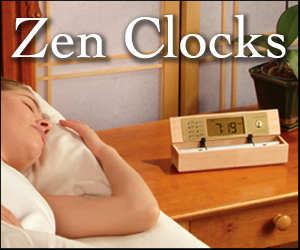 zen and the art of waking Now & Zen
1638 Pearl St.
Boulder, CO 80302
(800) 779-6383
Posted in Bamboo Chime Clocks
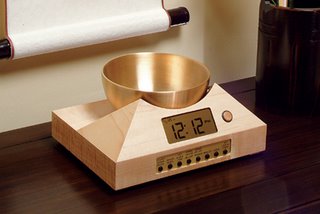 Zen Alarm Clock with Gradual Chime, No Snooze Buttons Allowed! The latest batch of high-tech alarm clocks explode, roll away, fly away and even make you solve math problems to keep you from oversleeping.
Our Zen Timepiece’s acoustic 6-inch brass bowl-gong clock is the world’s ultimate alarm clock, practice timer, and “mindfulness bell.” There are no gimmicky snooze buttons or sounds! When the clock’s alarm is triggered, the acoustic chime bar is struck just once … 3-1/2 minutes later it strikes again … chime strikes become more frequent over 10 minutes … eventually striking every 5 seconds until shut off. As they become more frequent, the gentle chimes will always wake you up – your body really doesn’t need to be awakened harshly, with a Zen Clock you’re awakened more gradually and thus more naturally. Unlike artificial recorded sounds coming out of a tiny speaker in a plastic box, natural acoustic sounds transform your bedroom or office environment.
It fills your environment with beautifully complex tones whenever it strikes. In the morning, its exquisite sounds summon your consciousness into awakening with a series of subtle gongs that provide an elegant beginning to your day. Once you experience the Zen Timepiece’s progressive awakening, you’ll never want to wake up any other way. It also serves as the perfect meditation timer. Available in 5 wood styles, including bamboo (not shown).
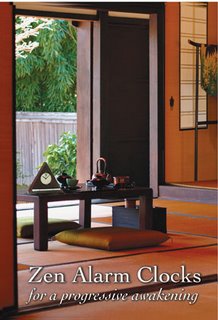 No Snooze Button Alarm Clocks, Zen Clocks Can Change Your Life
Now & Zen – The Zen Alarm Clock Store
1638 Pearl Street
Boulder, CO 80302
(800) 779-6383
Posted in Zen Alarm Clock, Zen Timepiece by Now & Zen, Zen Timers
 relaxation By Julie Dugdale
You’re caught defenseless—in line at the grocery store of all places. It’s as if someone amped up the fluorescent lights by a zillion watts, and you’re trapped in the glare. As sweat trickles down your back, your heartbeat quickens. Your chest constricts like a giant fist closing around your ribs. Your upper body starts shaking, but you can’t take a breath to steady yourself—there’s not enough air. The shopping carts, magazine racks, and aisles start to contort as dizziness warps your senses. Maybe I’m having a heart attack, you think. Suddenly, you’re 100 percent sure you’re dying, right there in the checkout lane.
Sound at all familiar? You’re not dying—you’re having a panic attack. This sudden flash of terror, which can last 10 minutes, is a hallmark of panic disorder—one of a half-dozen forms of anxiety. Every year, anxiety disorders wreak havoc on 40 million Americans, lasting six months or longer and evoking fear or uncertainty that makes it difficult to function in daily life. As such, anxiety is closely related to depression: Almost 50 percent of patients diagnosed with depression are also diagnosed with some form of anxiety. (See “What Kind of Worrier Are You?” on page 34 for a complete list of anxiety disorders.)
Are you at risk for anxiety disorders? First, check your family history: According to the National Institute of Mental Health, the tendency toward panic episodes is hereditary. “All of us are different biologically, and some of us are more prone to anxiety,” says James Gordon, MD, founder and director of the Center for Mind-Body Medicine in Washington, DC, and author of Unstuck: Your Guide to the Seven-Stage Journey Out of Depression (Penguin, 2009). Life experiences play a role, too. “Some of us are more vulnerable because we’re subject to circumstances—like being in a war—where an anxiety attack might be triggered.” Gordon says. Of course, it doesn’t take war to bring on an attack. Family conflict, money problems, job loss—all of these events can set off anxiety.
 relax Problem is, when it comes to combating anxiety in our culture, we tend to gloss over the circumstances, Gordon says. There is a tendency to focus on snuffing out the symptoms with medication, rather than rooting out the actual causes. Conventional treatments like benzodiazepines (potent anti-anxiety drugs), beta-blockers (heart medications that treat physical symptoms of certain anxiety disorders), and SSRIs (selective serotonin reuptake inhibitors, or antidepressants, including Prozac, Paxil, Zoloft, Lexapro, and Celexa) work at the surface, not at the source. These medications do not cure anxiety; they get the symptoms under control temporarily by altering brain chemistry. Side effects can range from nausea and jitteriness to sexual dysfunction and addiction. “Instead of falling into the narrowness of a medical model where you identify symptoms and apply treatment to those—you have to ask what is going on in your life,” Gordon says. “You have to look at what is making you the most anxious. It’s about finding a state of balance rather than tranquilizing yourself.”
Here, we identify some therapies to help you reach the origin of your worries. Along the way, you’ll need strategies to take the edge off your stress without medicating. We’ve got you covered there, too.
Breathe deep
 deep breathing Mastering your breathing is key to controlling anxiety. Anxious people tend to breathe shallowly, staccato-like, from the chest. Instead, find a quiet space and make a concerted effort to breathe long and deep through the nose and mouth so your belly goes in and out. “With coherent breathing and smooth inhalation and exhalation, you’re actively calming your state,” says Philip Muskin, MD, professor of clinical psychiatry at Columbia University. “The built-in effects of slow abdominal breathing counter the effects of hyperventilation. You can use this technique to re-center yourself.” Try five breaths per minute for five minutes, several times a day.
Stretch out
A significant body of recent research, including a 2010 review published in the journal American Family Physician, shows that yoga is an effective anti-anxiety practice because it improves mood, attention span, mental focus, and stress tolerance. The benefits of Sudarshan Kriya yoga (SKY)—a form of yoga that focuses on cyclical breathing—were detailed in a 2005 article in the Journal of Alternative and Complementary Medicine. According to the report, SKY helped survivors of the tsunami in Southeast Asia and the wars in Bosnia and Iraq overcome post-traumatic stress disorder, depression, anxiety, and insomnia. Try practicing 30 minutes of yoga per day.
Energize and balance
Qigong, a Chinese form of meditation that combines slow, deliberate breathing and graceful movement, is believed to ward off anxiety by revitalizing and centering energy. Similarly, the Japanese massage practice of reiki targets energy: A practitioner lightly places his palms on your chakras (major energy points), boosting the flow of internal energy. The New York–based Center for Reiki Wellness and Hypnosis recommends at least four reiki sessions, either weekly or biweekly, for the best results.
Mind your kidneys
From a Chinese medicine perspective, anxiety is related to kidney function, explains Rebecca Wood, author of the New Whole Foods Encyclopedia (Penguin, 2010). Specifically, poor kidney function throws off your qi (energy), directly resulting in anxiety. “The kidneys are your grounding, your anchor,” Wood says. Keep your kidneys healthy, she advises, by eating foods that support kidney function, such as root vegetables, seaweed, beans, meat, fish, and poultry. (For more natural ways to boost kidney health, read “Keep Your Kidneys Healthy” at naturalsolutions mag.com.)
 calming lavendar Try a supplement regime Targeted supplements can help ease your anxiety. Here are a few nutritional and herbal remedies to try. But remember, supplements should be taken only after consulting a practitioner or physician, especially if taken in conjunction with other anxiety medications, as some interactions could be harmful.
GABA
One of the main objectives in treating anxiety is to enhance the activity of GABA, a neurotransmitter responsible for relaxation and reducing worry. GABA is also an amino acid, and low levels of GABA can increase tendencies toward tension, depression, and sleeplessness. Upping your GABA can slow breathing, relax muscles, and shift mood.
Take: 100 to 500 mg two to three times daily.
Inositol
This nutrient balances serotonin, a neurotransmitter that affects mood. According to Richard Bloch, PhD, professor of psychiatric medicine at East Carolina University, high doses of inositol reduce panic attacks, with side effects comparable to SSRIs.
Take: 12 to 18 grams in tablet or powder form daily. Start with a lower dosage to see how your body reacts.
Kava
A native of the South Pacific, kava has been used for thousands of years to help anxiety. Its root was traditionally chewed or ground into a drink and is still valued today for its sedative and muscle-relaxant properties. “Kava is found to help generalized anxiety disorder,” Bloch says, referring to chronic anxiety characterized by constant and exaggerated worry, tension, and fatigue. “If it did not have unpredictable, although rare, liver complications, it would be a great way to avoid medical visits. But because of the possible dangers of side effects, it should be used with physician monitoring.”
Take: 300 mg as capsules, tinctures, or powder or 200 mg of kavalactones, the active ingredient taken directly from the lateral roots.
L-theanine
This amino acid found in green tea enhances activity in the GABA neurotransmitter. A 2005 article published in Alternative Medicine Review suggests that L-theanine increases alpha brain waves—those that keep you alert yet relaxed—just 40 minutes after ingesting.
Take: 200 mg two to three times daily, or drink three cups of tea.
Magnesium
Magnesium is one of the most common deficiencies in the American diet, says registered herbalist Roy Upton, RH, president and CEO of the American Herbal Pharmacopoeia. According to Australian and New Zealand Journal of Psychiatry, 68 percent of American adults get less than the recommended daily allowance of magnesium. The same study showed that symptoms of both depression and anxiety decrease when dietary intake of magnesium increases.
Take: 650 mg daily.
Valerian
Known as “nature’s valium,” valerian has a tranquilizing effect on neurotransmitter activity in the brain, creating an overall calming sensation similar to the drug, minus the unwanted side effects.
Take: 50 to 100 mg two to three times each day.
Talk it out
A 2008 study of patients with panic disorder showed that more than 70 percent had fewer symptoms (fear, heart palpitations, shortness of breath) following 12 weeks of psychodynamic psychotherapy, aka talk therapy. Talking about what’s bothering you can help you identify negative thinking patterns—and, eventually, reshape those patterns. “Talk therapies work pretty well for anxiety disorders,” says Muskin, “because you’re involved with another professional who’s talking to you and with you.”
Confront it
A next step might be cognitive behavioral therapy (CBT), a more specific type of talk therapy through which you learn to change the way you react to situations that may induce panic and anxiety. According to the National Association of Cognitive-Behavioral Therapists, CBT is “based on the idea that our thoughts cause our feelings and behaviors, not external things like people, situations, and events.” Thus, we can change our reactions even if the external situations remain the same. Muskin cites a CBT technique called “gradual exposure,” which introduces the patient to panic-inducing situations in increasing doses, eventually desensitizing the person to the fear. “For example: For a fear of bridges, you’d start by talking about bridges, then looking at them, and then, eventually, walking over a bridge.”
Let it go
 let it go Hypnotherapy can be used in conjunction with cognitive behavioral therapy to further reduce anxiety, as it’s based on a similar premise of changing the way you perceive events or situations. Here’s how it works: A certified clinical hypnotherapist (find one at natboard.com) guides you toward a deep state of focused relaxation, introducing mental imagery that suggests a symptom-free scenario. Your body relaxes as your heart rate and blood pressure slow down, and your mind becomes more engaged with the suggestions the therapist offers, enabling you to “disassociate” from the thoughts responsible for your anxiety. You never lose consciousness, which theoretically allows you to reflect on what you were able to let go of while coming out of the trance state.
Remember: Whether you’re a chronic worrier or only occasionally panic-ridden, anxiety can take its toll. Before you feel the next attack coming on, come up with your own plan for relaxation—being prepared is your best defense.
WHAT KIND OF WORRIER ARE YOU?
Anxiety comes in many forms. It may be constant or fleeting, uncomfortably acute or very broad. Here, we break down the major variations, courtesy of the experts at the National Institute of Mental Health.
If you’re one of 6.8 MILLION AMERICANS who is currently dealing with generalized anxiety disorder,
You’re feeling: Worried about everything and nothing, all the time; fatigued; and frustrated.
If you’re one of 15 MILLION AMERICANS who have social phobia,
You’re feeling: Extremely self-conscious in social situations, always worried that others are watching and judging you.
If you’re one of 2.2 MILLION AMERICANS who is plagued by obsessive-compulsive disorder,
You’re feeling: Compelled to complete certain rituals and check up on circumstances, like a locked door; intensely afraid of germs and dirt; the need to wash your hands over and over.
If you’re one of 7.7 MILLION AMERICANS who suffers from post-traumatic stress disorder (PTSD),
You’re feeling: On edge and hypervigilant for no reason; irritable; isolated or emotionally numb; unable to concentrate due to pervasive and frightening flashbacks and memories.
If you’re one of 6 MILLION AMERICANS who have panic disorder,
You’re feeling: Terrified about when your next panic attack will occur and afraid to return to the spot of your last one. Twice as many women as men are affected by this disorder; about one-third develop agoraphobia, or a fear of being in a place where escape might be difficult.
COPING WITHOUT MEDS
 coping without meds
10 more tips to minimize your stress naturally, from the Anxiety Disorders Association of America
1. Step back from the problem. Find another activity that helps you relax.
2. Don’t skip meals. Have snacks on hand to make sure your blood sugar is stable. The brain uses more sugar than any other organ, and fluctuating blood-sugar levels translate to an unbalanced mental state.
3. Sleep as much as you can. Your body needs more rest when it’s stressed, as reacting to anxious feelings eats up energy, and sleep is the body’s natural means of restoring that energy.
4. Count to 10 slowly. Repeat.
5. Accept that you can’t control everything.
6. Be OK with your best, even if it’s not perfect.
7. Seek out humor, and let yourself laugh.
8. Get involved in your community. Find a support network.
9. Write in a journal when you’re feeling anxious, and look for patterns.
10. Talk with your family and friends. Don’t keep it inside.
One of the ultimate Zen like experiences is waking-up from a great slumber refreshed and energized. Your mind and body are harmoniously one, both alert and focused. Having a refreshed mind and body are two keys to a natural and Zen lifestyle. Waking up in the morning should not be a loud and abrupt awakening, but rather it should be a peaceful positive experience. The right natural alarm clock can transition your deep and tranquil sleep into a serene start to consciousness. Imagine a long-resonating Tibetan bell-like chime waking you up to a beautiful morning experience.
The right alarm clock can be the most beneficial investment for you. With our Now & Zen natural alarm clock you are awakened more gradually and thus more naturally. Now & Zen is focused on creating a naturalistic lifestyle, and our clocks are an example of our philosophy.
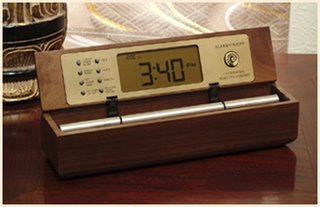 choose a gentle alarm clock with acoustic sounds to reduce stress Now & Zen’s Peaceful Chime Alarm Clocks
1638 Pearl St.
Boulder, CO 80302
(800) 779-6383
Posted in Well-being
 help with mind-body exercises
by Kristin Bjorsen
These three mind-body exercises—which you can do anywhere, anytime—calm the mind, alleviate PTSD symptoms (or any anxiety you may feel), and help you regain control of your life.
1. Soft-belly meditation: While sitting or lying down, breathe in through your nose and out your mouth. Allow your belly to be soft, letting it rise and fall gently. During the inhale, say the word soft to yourself, stretching it for the duration of the inhale. On the exhale, say, belly. Do this for seven minutes. You should see a drop in your blood pressure and heart rate.
2. Autogenic training: Lie comfortably, and do soft-belly breathing for a few minutes. Then slowly repeat the phrase “My arms are warm and heavy” six times. Now do the same with the following phrases: “My legs are warm and heavy”; “My heartbeat is calm and regular”; “My abdomen radiates warmth”; “My forehead is cool”; “My breathing is easy.” If you don’t have time to do all six phrases, do the first, second, and last one. This simple exercise will activate the calming, parasympathetic nervous system. Perform it in the morning and then during the day or at night if you’re feeling anxious or restless.
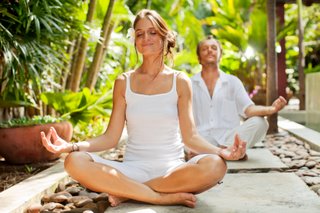 easy mind-body exercises 3. Energy tapping: If a stressful emotion or disturbing thought strikes, allow yourself to experience it fully. On a scale of 0 to 10, decide how bad it is. Then with a fingertip, tap on each of these points for a few seconds: the center of the forehead (the “third-eye” point), underneath the nose, the center of the chin, or the center of the sternum. Check in again on the problem. If it still registers on the scale, tap on the points that helped the most for several seconds. Repeat until the emotion or thought no longer registers and you feel calm and serene.
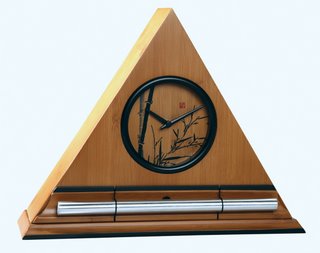 Wake up with Acoustic Chimes Now & Zen
1638 Pearl St.
Boulder, CO 80302
(800) 779-6383
Posted in Meditation Timers, Meditation Tools, mindfulness practice
 Stillness
In the larger scheme of things, our days on this planet are few and precious, so it seems fitting that we should begin each day with grace and beauty. Used as an alarm clock, your Zen Timepiece thus serves as a useful reminder that each day is a new and sacred opportunity to live life to its fullest.
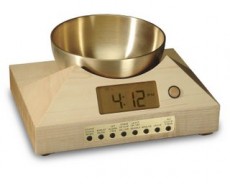 Zen Timepiece in Maple But in addition to its use as an alarm clock, your Zen Timepiece is also an aesthetically-sophisticated timer that enhances practice activities and social gatherings. It can also serve as a “mindfulness bell” that periodically calls you to stillness.
Founded in Boulder, Colorado in 1995, Now & Zen’s mission is to create natural lifestyle products that make a real difference in people’s lives. The growing preference for natural foods and natural fibers is carried forward by Now & Zen in the natural acoustic sounds and natural hardwood materials featured in every Now & Zen product. Our way of describing the essence of a natural lifestyle is: quality of thought, stillness of being.
 The Zen Alarm Clock Store Now & Zen’s Shop – Mindfulness Bells & Chime Timers
1638 Pearl Street
Boulder, CO 80302
(800) 779-6383
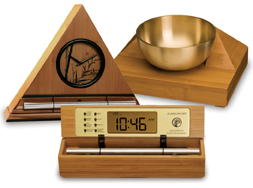 Tibetan Singing-bowl Timer & Chime Mediation Clocks
Posted in Meditation Timers, Meditation Tools, Natural Awakening, Now & Zen Alarm Clocks, Zen Gardens, Zen Timepiece by Now & Zen, Zen Timers
 Flowering Plum and Moon, Koson Inspire your afternoon or evenings and refresh your senses by creating sacred space for a personal tea ceremony.
From the fragrant aromas to the delicate flavors to the simple comfort of a warm mug, tea is a meditation for the senses. It also creates space to unwind and reconnect.
Preparing it is a process, one that forces you to slow down and relax. “Tea is a gift from the earth,” says Diana Rosen, author of “Meditations With Tea,” “and enjoying it is a gift to yourself.”
By creating your own daily tea ritual in the afternoon when the day tends to drag, you can refresh your senses, refocus your thoughts, enjoy some peace, and — the best part — introduce a sacred moment into your day.
Prepare for Tea
In one traditional Japanese tea ceremony, guests are met at the gate by their host and led silently through a garden to the tea room, signifying a departure from the everyday world and an entrance into a spiritual realm.
You probably don’t have a dedicated tea room, but you too can create a space in your afternoon for disconnecting from the day’s stresses, whether you’re at the office or at home. Here’s our simple step-by-step approach to creating your own personal tea ceremony.
Dedicate a Space
This can mean moving to another room, a favorite chair, or just to the other side of your desk — or simply clearing a space for tea on your table or work space. You might consider using a place mat or a tray to visually set your tea space apart from everything else.
 Teapot and cup with green tea Set the Stage
A tea ceremony is about atmosphere. Light a candle or play music to set the mood. If you’re in a busy office, just close your eyes and listen to your breath for a few minutes to switch gears and set the tone. Set your Zen Alarm Clock so that you will hear a lovely chime at the end of your tea time.
Select Your Tea
Bring some intention to your choice. What are you in the mood for? A mild, grassy green? A refreshing peppermint? A rich, vibrant oolong or black tea? As Confucius said, “Let your palate be your guide.”
Use Your Favorite Accoutrements
The personal objects you use for tea making will help make this practice your own. Whether it’s a pretty mug, an iron teapot, or a favorite infuser, using something special for your tea ritual inspires a ceremonial feel. Set your Zen Alarm Clock & Timer to time your tea for 5 minutes for optimal taste.
exerpted from Body + Soul, September 2005
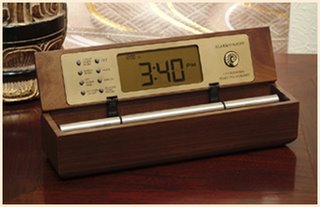 Digital Zen Timer, good for timing tea Now & Zen’s Chime
Timer Store
1638 Pearl Street
Boulder, CO 80302
(800) 779-6383
Posted in Chime Alarm Clocks, Japanese Inspired Zen Clocks, mindfulness practice, Now & Zen Alarm Clocks
|
|
|
|